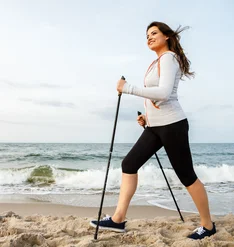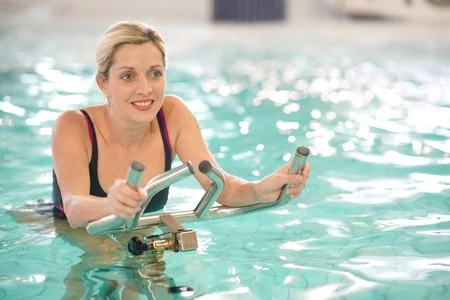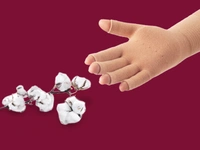Lipedema and exercise
Is lipedema resistant to exercise?
Lipedema is an abnormal deposit of fat under the skin and almost exclusively occurs in women. Those suffering from lipedema are often told: ‘Lipedema is resistant to exercise’. But is there anything to this claim?
Exercise is not a cure, but it can alleviate the symptoms
Here are the facts: lipedema is an adipose tissue (fatty tissue) disease which cannot be stopped by excessive exercise and dieting. And as if the constant increase in size and weight weren’t enough, those affected usually suffer a lot of pain, too. However, physical activity can prevent the formation of additional non-lipedema fat deposits, and it can also help prevent the development of secondary lymphedema (often called lipo-lymphedema). Even if exercise cannot provide the promise of a cure for lipedema, it can significantly reduce its symptoms. In the following, you’ll discover what this entails.
Exercise as an integral part of CDP
When treating lipedema and lymphedema, a method called complex decongestive physiotherapy (CDP) is usually deployed. It is designed to alleviate pains and to prevent complications like joint issues or the development of lipo-lymphedema. CDP consists of manual lymphatic drainage, compression therapy, skincare, exercise and self-management. Exercise and self-management do not only promote successful treatment but can also improve the patient’s quality of life and boost their perseverance.
What do lipedema patients need to consider when exercising?
A lipedema sufferer’s motto: reduce weight and/or don’t gain any more weight. It’s not so much about weight training, however, but rather about moderate full-body workouts and endurance training. What’s particularly important is that the exercise is easy on the joints to prevent further damage to the already strained joints.
Whenever possible, lipedema patients should make sure to wear their compression stockings or tights when exercising. The reason for this is that the compression supports the muscles, veins and the lymphatic system in transporting blood towards the heart and lymphatic fluid towards the lymph nodes. The lymphatic and venous systems of lipedema patients often function to a limited extent. Without the supportive compression, there’s a risk of fluid accumulating in the tissue which would lead to further complications or swellings (edema).


These sports are particularly suitable for Lipedema patients:
- Exercising in water: Whether it’s swimming, aqua cycling, aqua fitness, aqua walking or water gymnastics – exercising in water is not only low-impact, but also very effective. That’s because the water pressure acts like a lymphatic drainage and helps to clear the fluid in the legs. This also means that water sports are the only type of exercise that can be done without compression. A beneficial side effect: the water’s buoyancy reduces the body weight to a minimum. What’s more, you get a full-body workout as not only legs, but also the back, arms and core are exercised.
- Trampolining: This is another very effective type of sport that goes easy on your body. The bouncing does not only strengthen your muscles, but also stimulates the lymph flow – and let’s not forget that it also boosts the burning of fat. The muscles are tensed when jumping and relax again once you’re in the air. Compression stockings further support the blood flow and transport of lymphatic fluid in the body. All movements are easier on a trampoline. And that’s not all: even your intervertebral discs benefit from trampolining. The jumping makes the spine contract, which in turn triggers a better fluid supply to the intervertebral discs. Trampolining can thus also be used as a preventative measure against slipped discs.
- Fascia training: Fasciae are part of the connective tissue and surround joints, muscles and bones as well as the lymphatic vessels like a shell. They consist of water, collagen and adhesive matter. If the lymph drainage does not function properly (which often occurs in the case of lipedema), fibrinogen will accumulate in the lymphatic vessels, which can cause the fasciae to clog. Clogged-up fascia tissue can be a cause of the lipedema pain. Fascia training is designed to loosen this clogged-up connective tissue again and to soften the fasciae. Fascia massage rollers in different sizes and with varying intensities can help to loosen the tissue. Please note: Using these rollers can be quite painful initially, until the clogged-up fasciae are starting to loosen up.
- Nordic walking: This exercise trains a variety of muscle groups and even includes the arms – an area which is sometimes affected by lipedema. The walking with sticks is particularly gentle on the joints and can be learned quickly by beginners.
- Cross trainer: Effective endurance training that is easy on the body can also be achieved with equipment like the cross trainer. Amongst other muscle groups, it trains the legs, arms, core and glutes. Unlike jogging, this type of exercise does not cause any stress on the joints.
- Training with alternating pressure: Special exercise equipment combines moderate training that’s easy on the joints with elements that promote blood circulation. This equipment utilises positive and negative pressure by exposing the tissue to a vacuum, which stimulates the blood flow – similar to cupping therapy.
Encouraging others and being a role model
According to estimates, every tenth woman in Germany suffers from lipedema. Meet our #LipödemMutmacher – these are inspiring women who open up about this condition and who show others how they overcome its challenges. Each one has a fascinating story to tell. We are proud that they share this story with us and encourage others. Read their stories of encouragement.





